Dere Street: Difference between revisions
Created page with "right|thumb|250px|Roman roads: Dere Street in blue {{county|Nothumberland}} '''Dere Street''' or '''Deere Street''', was a Roman road bet..." |
No edit summary |
||
| (One intermediate revision by one other user not shown) | |||
| Line 1: | Line 1: | ||
[[File:Roman Roads in Britannia.svg|right|thumb|250px|Roman roads: Dere Street in blue]] | [[File:Roman Roads in Britannia.svg|right|thumb|250px|Roman roads: Dere Street in blue]] | ||
{{county|Nothumberland}} | {{county|Nothumberland}} | ||
'''Dere Street''' or '''Deere Street''', was a Roman road between ''Eboracum'' ([[York]]) and the [[Firth of Forth]] or at its greatest estimate extent, to the Roman fort at [[Inchtuthil]], north of the [[River Tay]] in [[Perthshire]]. It | '''Dere Street''' or '''Deere Street''', was a Roman road between ''Eboracum'' ([[York]]) and the [[Firth of Forth]] or at its greatest estimate extent, to the Roman fort at [[Inchtuthil]], north of the [[River Tay]] in [[Perthshire]]. It stretches therefore, perhaps some 226 miles. | ||
The route still exists in the form of the route of many major roads, including the A1 and A68 just north of ''Coria'' ([[Corbridge]]). | The route still exists in the form of the route of many major roads, including the A1 and A68 just north of ''Coria'' ([[Corbridge]]). | ||
| Line 25: | Line 25: | ||
==Cheviots to the Forth== | ==Cheviots to the Forth== | ||
[[File:Dere Street Woden Law Scottish Borders.jpg|thumb|Iron Age hill fort at Pennymuir]] | [[File:Dere Street Woden Law Scottish Borders.jpg|right|thumb|200px|Iron Age hill fort at Pennymuir]] | ||
The A68 follows close to the route of Dere Street through the Cheviots, by way of [[Carter Bar|Carter Fell]]; on the fell are the remains of a camp at [[Pennymuir]]<ref>[http://www.discovertheborders.co.uk/places/136.html Pennymuir camps under snow]</ref> and well preserved sections of the road as it also forms part of [[St | The A68 follows close to the route of Dere Street through the Cheviots, by way of [[Carter Bar|Carter Fell]]; on the fell are the remains of a camp at [[Pennymuir]]<ref>[http://www.discovertheborders.co.uk/places/136.html Pennymuir camps under snow]</ref> and well preserved sections of the road as it also forms part of [[St Cuthbert's Way]] to ''Trimontium'' near [[Melrose]]. Crossing the [[River Tweed]] at ''[[Trimontium]]'', the route follows the [[Leader Water]] to the foot of the [[Lammermuir]]s, where there is evidence of forts near [[Oxton, Berwickshire|Oxton]] and another well preserved section of road rises through the Lammermuirs over [[Soutra Aisle|Soutra]] hill, and then on to the Votadini stronghold of ''Din Eidyn''; [[Edinburgh]]. Here the Romans held strategic garrisons at [[Cramond]] and at [[Inveresk]] to access the eastern end of the [[Antonine Wall]].<ref name="HistoricScotlandDereStreet">{{cite web|url=http://www.historic-scotland.gov.uk/index/places/propertyresults/propertydetail.htm?PropID=PL_087&PropName=Dere%20Street%20Roman%20Road,%20Soutra|title=Historic Scotland|work=Dere Street Roman Road|accessdate=16 January 2010}}</ref> | ||
==After the Romans== | ==After the Romans== | ||
| Line 53: | Line 53: | ||
==Notes== | ==Notes== | ||
*Location map: {{wmap|55.0566|-2.06543}} | |||
{{reflist}} | {{reflist}} | ||
| Line 63: | Line 64: | ||
* [http://www.prestoungrange.org/core-files/archive/university_press/19_roads_that_led/19_p13_p21.pdf A look at some of the ancient roads passing through East Lothian, including a section of Dere Street] | * [http://www.prestoungrange.org/core-files/archive/university_press/19_roads_that_led/19_p13_p21.pdf A look at some of the ancient roads passing through East Lothian, including a section of Dere Street] | ||
* [http://www.bbc.co.uk/dna/h2g2/A49097587 BBC: Dere Street – From York to Melrose in Seven Days] | * [http://www.bbc.co.uk/dna/h2g2/A49097587 BBC: Dere Street – From York to Melrose in Seven Days] | ||
[[Category:Roman roads]] | [[Category:Roman roads]] | ||
[[Category:Roads in Berwickshire]] | |||
[[Category:Roads in County Durham]] | |||
[[Category:Roads in East Lothian]] | |||
[[Category:Roads in Midlothian]] | |||
[[Category:Roads in Northumberland]] | |||
[[Category:Roads in Roxburghshire]] | |||
[[Category:Roads in Yorkshire]] | |||
Latest revision as of 12:41, 10 January 2016
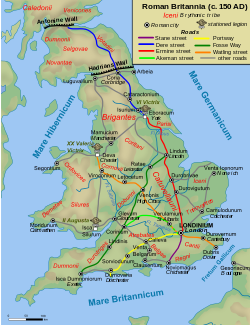
Dere Street or Deere Street, was a Roman road between Eboracum (York) and the Firth of Forth or at its greatest estimate extent, to the Roman fort at Inchtuthil, north of the River Tay in Perthshire. It stretches therefore, perhaps some 226 miles.
The route still exists in the form of the route of many major roads, including the A1 and A68 just north of Coria (Corbridge).
The name given to the road corresponds with the Dark Age Anglo-Saxon kingdom of the Deirans (Dere), through which the first part of its route lies. It was sometimes referred to as "Watling Street" and marked on some maps as such, which cause it to be confused with the Watling Street that linked Dover with Wroxeter.
Route
York to Catterick

The route began at York[1] and crossed the River Ure near Isurium Brigantum (present-day Aldborough close to Boroughbridge). From there, it crossed the River Swale near Catterick, a garrison town then as now, where the Roman fort was called Cataractonium.
River Tees crossing

Dere Street went on to cross the River Tees near the Roman fort of Piercebridge by a stone arch bridge: These are relatively rare in Roman Britain,[2] except for Hadrian's Wall and Dere Street. The original bridge at Piercebridge was replaced by another on a different alignment, and there is some evidence for other minor realignments of Dere Street over the Roman period.[3] Raymond Selkirk has suggested that the supposed remains of a Roman stone bridge on the south side of the Tees at Cliffe are remains of a jetty, and archaeological television programme Time Team investigated this in 2009.[4][5] In 1994, a section through Dere Street was exposed by excavations carried out in a garage development area at Cliffe, and some pottery and tile found.[6][7]
Bishop Auckland to the Cheviot Hills
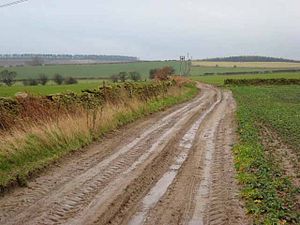
The next river crossing was of the River Wear at the Roman fort of Vinovia, near present-day Bishop Auckland.[8] At this point another road branched away to the right, heading for Durham, Chester-le-Street and eventually crossing the Tyne at Pons Aelius (Newcastle upon Tyne).[9]
From Vinovia, Dere Street travelled onwards past the Roman forts of Longovicium (present-day Lanchester) and Vindomora (Ebchester), before crossing the River Tyne near the fort of Coria (Corbridge), where it crossed Stanegate.[10][11] Just North of Corbridge, the route passed through the fortifications of Hadrian's Wall, at a point now known as Portgate, and passed into lands that were only tenuously under Roman domination.[12]
From the Wall, the route continued north into Redesdale and thence to the Cheviot Hills, where there are the remains of marching forts at Fourlaws, Habitancum (West Woodburn), Bremenium (Rochester), and at Chew Green.[12]
Cheviots to the Forth
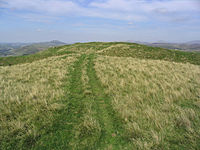
The A68 follows close to the route of Dere Street through the Cheviots, by way of Carter Fell; on the fell are the remains of a camp at Pennymuir[13] and well preserved sections of the road as it also forms part of St Cuthbert's Way to Trimontium near Melrose. Crossing the River Tweed at Trimontium, the route follows the Leader Water to the foot of the Lammermuirs, where there is evidence of forts near Oxton and another well preserved section of road rises through the Lammermuirs over Soutra hill, and then on to the Votadini stronghold of Din Eidyn; Edinburgh. Here the Romans held strategic garrisons at Cramond and at Inveresk to access the eastern end of the Antonine Wall.[14]
After the Romans
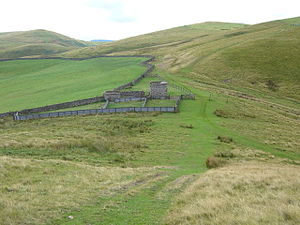
In the High Middle Ages, the section of the route between Jedburgh and Edinburgh was known as the Via Regia or royal way. The Via Regis connected the larger part of Scotland with the important ecclesiastic sites of the border shires. King Malcolm IV established his Church and Hospital of the Holy Trinity halfway along this section to provide succour for the many pilgrims using it.[15]
After the destruction of the Border Abbeys during "The Rough Wooing" by the Earl of Hertford's forces of Mary, Queen of Scots, and the Reformation of the Church of Scotland, the route fell into disuse and disrepair; and it was used mainly for driving livestock, and the occasional travellers daring enough to venture into the lawless border region.[16]
Mediæval travel on Dere Street
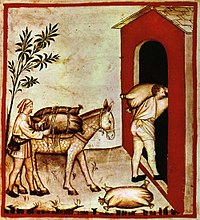
Dere Street continued in use between Durham and York in mediæval times. Being limited by daylight, "about thirty miles in a day in winter on horseback and between thirty-six and forty in summer was what a man could do." Tough, vigorous men could walk from Darlington to York, and it was said that the quality of a horse could make the difference between a possible thirty and fifty miles per day. A wish to hear mass or the organisation of a train by the rich could shorten the travelling day to twenty miles.
Roads were described as so muddy and difficult between November and February that to finish the journey by daylight one could barely stop to eat; however a "royal highway" or alta via regia strata was passable in winter between York and Durham, and this could have been Dere Street. Heavy packhorse loads were taken on the route, for example 20 stone of wool. Clerics, traders and the nobility were more likely to travel than others, and some people rarely travelled at all. Travelling in style involved the use of carts for luggage, but carts bogged down in winter mud, so traders with packhorses travelled more easily in winter than the rich.[17]
Pictures
-
Legg's cross near Bolam in County Durham
-
Dere Street at Bildershaw, County Durham
-
Wheelbirks bridge, near Hindley, Northumberland
-
Milestone at West Woodburn, Northumberland
-
Dere Street at Bonjedward, Roxburghshire
-
Dere Street at Crailinghall, Roxburghshire
-
Dere Street at Maxton, Roxburghshire
-
Dere Street at Gilston, East Lothian
Notes
- Location map: 55°3’24"N, 2°3’56"W
- ↑ ie the route of what we now call Dere Street. The Antonine Itinerary gives 3 routes which pass over Dere Street; none actually begin or end in York
Davies, Hugh Roman Roads in Britain Stroud 2002 ISBN 0-7524-2503-X, pp 20–21 - ↑ Davies Roads in Roman Britain p 93
- ↑ http://www.mcbishop.co.uk/oculus/derest.html
- ↑ Selkirk, Raymond (2000). Chester-le-Street & Its Place in History. Birtley, County Durham: Casdec Print & Design Centre. pp. 93–122. ISBN 1-900456-05-2.
- ↑ Lloyd, Chris (2 July 2009). "The Northern Echo". Piercebridge: Time Team investigates. http://www.thenorthernecho.co.uk/features/blogs/staff/echomemories/4472760.Time_Team_in_the_area/. Retrieved 12 January 2010.
- ↑ "Heritage Gateway". Listed buildings online, and local records. http://lbonline.english-heritage.org.uk. Retrieved 11 January 2010.
- ↑ NY SMR Number MNY12855; Old Sites & Monuments Record Number 12975.10000; Grid Reference NZ 212,155; SNY8056 Field recording Form, North Yorkshire County Council 15 November 1994, George Hotel Piercebridge (Dere Street Cottage), Campling, N. NYCC Observation Record
- ↑ Laurie, Barbara (2005). "bishopaucklandhistory.co.uk". A Short History of Bishop Auckland. http://www.bishopaucklandhistory.co.uk/. Retrieved 16 January 2010.
- ↑ "Pastscape, English Heritage". Dere Street Investigation History. Publications : Full report Proceedings of the Society of Antiquaries of Newcastle upon Tyne 2/1925/12:94-6. http://pastscape.english-heritage.org.uk/events.aspx?a=0&hob_id=1005251&type=&class1=None&period=None&county=None&place=corbridge&yearfrom=ALL&yearto=ALL&recordsperpage=60&source=text&sort=1&nmr=&defra=. Retrieved 16 January 2010.
- ↑ Bishop, M.C.. "Durham.ac.uk resources". Corbridge (archaeological resources). http://www.dur.ac.uk/resources/archaeological.services/research_training/hadrianswall_research_framework/project_documents/Corbridge.pdf. Retrieved 16 January 2010.
- ↑ Stanegate and Dere Street were about the same width (25 feet) but the much greater depth of metalling on Stanegate (28 inches as against 12 inches on Dere Street) is argued to reflect a greater frequency of resurfacing, and hence much greater traffic on Stanegate Davies Roads in Roman Britain p 57
- ↑ 12.0 12.1 "BBC". Dere Street – From York to Melrose in Seven Days. 10 June 2009. http://www.bbc.co.uk/dna/h2g2/A49097587. Retrieved 16 January 2010.
- ↑ Pennymuir camps under snow
- ↑ "Historic Scotland". Dere Street Roman Road. http://www.historic-scotland.gov.uk/index/places/propertyresults/propertydetail.htm?PropID=PL_087&PropName=Dere%20Street%20Roman%20Road,%20Soutra. Retrieved 16 January 2010.
- ↑ Hunter, James, FSA (Scot)., Fala and Soutra, including a History of the Ancient "Domus de Soltre", Edinburgh, 1892.
- ↑ Scotways.com. "Heritage Paths". Dere Street. http://www.heritagepaths.co.uk/pathdetails.php?path=197. Retrieved 16 January 2010.
- ↑ Harvey, Margaret M. (March 2005). "Travel from Durham to York (and back) in the fourteenth century". Northern History (Durham University Library) 1 (XLII): 119–130. http://dro.dur.ac.uk/2271/1/2271.pdf. Retrieved 16 January 2010.
Further reading
- The Roads of Mediæval Lauderdale, by R. P. Hardie, Edinburgh & London, 1942.
Outside links
| ("Wikimedia Commons" has material about Dere Street) |








